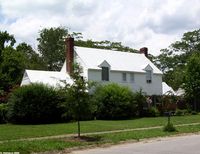Cahaba Homestead Village: Difference between revisions
No edit summary |
No edit summary |
||
| Line 6: | Line 6: | ||
==History== | ==History== | ||
The Cahaba Village was designed by the landscape architect [[W.H. Kestler]] in the early 1930s. Construction took place between [[1936]]-[[1938]] and resulted in the construction of 243 houses and 44 duplex units at an overall cost of $2,661,981.26. Each of these residences was leased by the federal government until being sold to private landowners in [[1947]]. The entire development was added to the [[National Register of Historic Places]] in [[2002]]. | The Cahaba Village was designed by the landscape architect [[W.H. Kestler]] in the early 1930s. Construction took place between [[1936]]-[[1938]] and resulted in the construction of 243 houses and 44 duplex units at an overall cost of $2,661,981.26. Each of these residences was leased by the federal government until being sold to private landowners in [[1947]]. The entire development was added to the [[National Register of Historic Places]] in [[2002]]. | ||
[[John Bratton]] founded the [[Holy Infant of Prague Catholic Church]] at Cahaba Village in [[1939]]. | |||
==Layout== | ==Layout== | ||
Revision as of 10:17, 10 August 2007

- This article is about the 1930s housing development. For the 2007 shopping center, see Cahaba Village (shopping center)
The Cahaba Village or "Slagheap Pile" is a depression-era residential development located in the heart of Trussville. It was constructed adjacent to the site of the original Trussville Furnace. The general style of the homes is American Foursquare with most having tin roofs within the development. The development is also referred to as being the Cahaba Project and the Cahaba Homestead Village Historic District.
History
The Cahaba Village was designed by the landscape architect W.H. Kestler in the early 1930s. Construction took place between 1936-1938 and resulted in the construction of 243 houses and 44 duplex units at an overall cost of $2,661,981.26. Each of these residences was leased by the federal government until being sold to private landowners in 1947. The entire development was added to the National Register of Historic Places in 2002.
John Bratton founded the Holy Infant of Prague Catholic Church at Cahaba Village in 1939.
Layout
Its extent is roughly bounded by Rockridge Avenue to the west, the Cahaba River to the east, Gadsden Highway to the south, and Poplar Street to the north. Chalkville Mountain Road serves as the main thoroughfare through the heart of the development. The street layout is irregular with tall oak trees lining the sidewalks.
The development is centered on the Trussville Mall. The "mall" is a large green space at the center of the development that has served as a gathering place for locals since its completion. At the eastern end of the mall is the current Hewitt-Trussville Middle School.